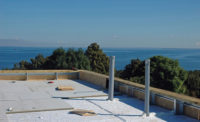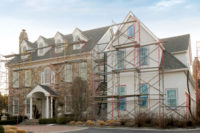
Ample windows allow for natural daylight in 90 percent of the space. All photos courtesy of LPA Inc./Costea Photography.
In these financially strapped times, people are getting creative with their finances. Lake Tahoe Unified School District has been doing the same, with incredible results for its students and community. After putting together a District Facilities Master Plan in December 2007, the district prepared for a bond which passed in September of 2008.
With no new construction eligibility dollars, what did the district get with just gumption and creativity? Plenty.
The district received almost $30 million in funds from Career Technical Education (CTE), Overcrowding Relief (ORG), and Joint-Use and High Performance Energy building grants. Between these monies, and the bond passed by the community, the district was able to create five extraordinary learning facilities for its students.
First to be completed was the $12.5 million CTE “Green” Construction and Transportation Academy. Second was a $12 million ORG-funded classroom building. To be finished in September is the $13 million Tahoe Arts and Design Academy. And lastly, a new Campus Commons Student Union and Sports Medicine Academy are to be up and running in 2012 and 2013, respectively.
Each project is CHPS* designed and qualified for a high-performance energy grant, beating California’s Title 24 energy standards by 30 percent (when space cooling is removed from energy calculations, as no mechanical cooling systems are provided).
-CTE_9383.jpg)
The CTE “Green” Construction and Transportation Academy is a two-story, 27,183-square-foot building.
Architecture: Derived from Safe Snow Melt
“Designing in the Sierras meant working with a severe climate that had strict restrictions on when we could and could not build,” says Wendy Rogers, a design principal at LPA Inc. “When the high school was originally established, someone took floor plans of architecture developed for the valley and reused them, thousands of feet up, in the mountains of Lake Tahoe.”Many of the existing buildings had flat roofs, which do not do well with snowfall, and in general, are not part of the overall aesthetic of South Lake Tahoe. After years of maintaining these ill-advised roofs, the district had a strong desire to rectify this dilemma; the safety of the students had to come first.
“When snow melts, it has a tendency to go very slowly and then, in a moment’s notice, come sheeting down. As you can imagine, managing where the snow lands is a really big deal,” says Rogers. “We did a lot of research and worked closely with the district and the people who live in Tahoe full-time, who know the subtleties of their microclimate.”
The solution? Two roof pitches on each facility that deal with winter snow loads. Steep southern pitches guide the snow melt to fall in dedicated areas, often into various rock and bioswales so the water can percolate into the ground and be taken to a retention basin or cistern. Shallow northern pitches, used minimally, collect snow for longer durations.
Although managing snow melt correctly was crucial for this project and for the safety of the students, this kind of design feature is not awarded with CHPS points.
-CTE_9100.jpg)
Natural daylight and exposed wood ceilings give a light and airy feel to the construction classroom.
Less Standardization and More Flexibility
Of the five facilities, the CTE Green Construction and Transportation Academy has been of particular interest. The academy exposes students to careers in green construction, auto mechanics and technology. The space offers labs for construction technologies, CAD drafting and graphic design, along with a 10-bay auto shop modeled after a commercial auto dealership. Here, students learn green automotive and transportation technologies including how to work on and repair hybrid vehicles.“Career Technical Education supports a different learning style,” says Dr. Jim Tarwater, superintendent of Lake Tahoe Unified School District. “It’s about giving students pathways for careers ranging from arts, media, entertainment and theater to construction, architectural design and automotives. These programs and their facilities work together at South Tahoe High School. We hope our students enjoy them and learn a lot.”
What does this mean for the design of Tahoe’s CTE Green Academy? Less standardization and more flexibility. Students excel with areas for groups to collaborate, areas for individual learning, and areas that allow project-based activities rather than strictly lecture-based instruction. Learning Labs are clustered around a shared space, staff work areas are easily accessible and visible to students, and outdoor learning is valued equally to indoor.
“All of these things change the shape of education and the architecture that supports it,” Rogers adds. “It’s about sustainability, not just for the environment, but in terms of giving students the skills they need to be able to stay in their community and thrive.”
-CTE_9110.jpg)
In this light-filled classroom, students hone their skills in CAD drafting and graphic design.
Sustainable features abound at South Tahoe High School's new projects
- Operable windows allow the buildings to breathe and take advantage of the South Tahoe climate - no mechanical cooling systems were used.
- Natural light illuminates spaces with daylighting and occupancy controls.
- Exposed wood structures and building systems create living laboratories and educational tools for students to experience smart green design.
- Learning courtyards incorporate fire-resistant plants native to (or adapted to) the Tahoe region. Vegetation is irrigated with water-efficient systems during warmer, dryer months.
- Buildings touch the site lightly to minimize impact on existing, mature pine trees.
- Stormwater runoff is collected and infiltrated in cobble trenches that penetrate the soil with excess water conveyed either to an onsite detention basin or subsurface “storm chamber” located under vehicular areas. This allows onsite stormwater to recharge the groundwater.
- Exterior lighting incorporates full, cutoff light fixtures which prevents light from projecting above the fixture, helping to preserve Tahoe’s dark skies and prevent glare into unwanted areas.
- Signage and graphics highlight attributes which make the project environmentally responsible. Sustainable signage is incorporated into the curriculum for “teachable moments” throughout the space.
- Material selection was guided by a “do more with less” approach. Wherever possible, the structure of the buildings is exposed (i.e., glu-lam beams, concrete block and concrete slabs) and becomes part of the finish palette.
- Finish material selections have high recycled content.
- All classrooms meet the stringent CHPS requirements for Sound Transmission Class (STC) standards.
-SB_9265.jpg)
This wet lab features natural daylight, an exposed wood ceiling and a fish tank for students to observe and enjoy.
Sidebar: Custom Order, by Kate Mraw, LEED AP
CTE Schools and a change in education.
Is education an industrial method best solved by a repetitive assembly-line approach about producing students? Historically, education has been delivered with an instructor at the front of a classroom and students lined up in rows of desks following along. When it comes to education and how students interact with their environment, it’s important to understand how learning styles vary between individual students.
Educational planning and the school environment have to change to stay ahead of the demands of a technologically advanced generation. Customizing education toward a student’s needs and customizing spaces that will support this refinement are quickly emerging.
Aside from the occasional increased use of technology in the classroom, with teachers using social media tools like Twitter and Edmodo to communicate with students, there are other influences beginning to change the shape of education, literally.
Career Technical Education (CTE) supports a different learning style. Students are faced with real-world challenges, projects and issues that encourage an interactive level of attention.
CTE is evolving from industrial-oriented classes to computer-based-learning and internships that enable students to form initial relationships and key knowledge with the outside community. Like at South Tahoe High School, these curriculums affect how school facilities are designed. The same way students expect instant access to answers on the Internet, they in turn deserve instant access to teachers, each other and to flexible spaces they can manipulate to their own needs.
CTE schools are seen as successful because students are now learning in collaborative and interactive environments. This generation is pushing a change in how LPA designs schools. Now, how can our schools push for a change in educational planning? Back to the assembly line, in order to create successful students? The one-size-fits-all mentality with educational delivery doesn’t fly. Is it time for a custom order?
Kate Mraw, LEED AP, is an Interior Designer at California-based LPA Inc. Her K-12 educational spaces encourage collaboration, experimentation and instruction.
*CHPS is the Collaborative for High Performance Schools. Its mission is to promote a national movement that facilitates the design, construction and operation of high-performance schools.
Is education an industrial method best solved by a repetitive assembly-line approach about producing students? Historically, education has been delivered with an instructor at the front of a classroom and students lined up in rows of desks following along. When it comes to education and how students interact with their environment, it’s important to understand how learning styles vary between individual students.
Educational planning and the school environment have to change to stay ahead of the demands of a technologically advanced generation. Customizing education toward a student’s needs and customizing spaces that will support this refinement are quickly emerging.
Aside from the occasional increased use of technology in the classroom, with teachers using social media tools like Twitter and Edmodo to communicate with students, there are other influences beginning to change the shape of education, literally.
Career Technical Education (CTE) supports a different learning style. Students are faced with real-world challenges, projects and issues that encourage an interactive level of attention.
CTE is evolving from industrial-oriented classes to computer-based-learning and internships that enable students to form initial relationships and key knowledge with the outside community. Like at South Tahoe High School, these curriculums affect how school facilities are designed. The same way students expect instant access to answers on the Internet, they in turn deserve instant access to teachers, each other and to flexible spaces they can manipulate to their own needs.
CTE schools are seen as successful because students are now learning in collaborative and interactive environments. This generation is pushing a change in how LPA designs schools. Now, how can our schools push for a change in educational planning? Back to the assembly line, in order to create successful students? The one-size-fits-all mentality with educational delivery doesn’t fly. Is it time for a custom order?
Kate Mraw, LEED AP, is an Interior Designer at California-based LPA Inc. Her K-12 educational spaces encourage collaboration, experimentation and instruction.
*CHPS is the Collaborative for High Performance Schools. Its mission is to promote a national movement that facilitates the design, construction and operation of high-performance schools.


